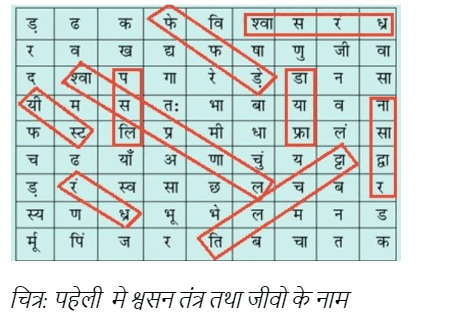NCERT Solutions For Class 7 Science Chapter 10 Respiration In Organisms in Hindi - 2025-26
FAQs on NCERT Solutions For Class 7 Science Chapter 10 Respiration In Organisms (2025-26)
1. How do you correctly answer the NCERT question about why an athlete breathes faster and deeper after a race?
According to the NCERT solutions for the 2025-26 syllabus, the correct way to structure this answer is by explaining the increased energy demand. During the race, the athlete's body needs more energy, which is produced by breaking down food through cellular respiration. This process requires a higher supply of oxygen. To meet this demand, the breathing rate increases. After the race, the body continues to breathe faster and deeper to repay the oxygen debt and remove the excess carbon dioxide produced.
2. What are the key similarities between aerobic and anaerobic respiration that should be included in an NCERT solutions-based answer?
For a complete answer as per the NCERT Class 7 Science textbook, you should list the following similarities:
Both processes start with the breakdown of glucose to produce energy.
Both aerobic and anaerobic respiration occur inside the cells of an organism.
In both types of respiration, energy is released and stored in the form of ATP (Adenosine triphosphate), although the amount of energy released is much higher in aerobic respiration.
3. How should a student solve the NCERT exercise question about why we sneeze when we inhale dust-laden air?
The step-by-step method to answer this is:
Start by explaining that the air we inhale is not always clean and may contain unwanted particles like dust and pollen.
Mention the first line of defence: the hair in our nasal cavity traps most of these particles.
Explain that sometimes, finer particles can get past the hair and irritate the lining of the nasal cavity.
Conclude by stating that sneezing is a reflex action to expel these foreign particles forcefully, ensuring they do not enter the lungs.
4. What is the correct way to explain muscle cramps after heavy exercise based on the concepts in Chapter 10?
The NCERT solution explains that during heavy exercise, the demand for energy is very high, but the supply of oxygen to the muscle cells can be insufficient. To meet the energy demand, muscle cells switch to anaerobic respiration. This partial breakdown of glucose produces lactic acid as a byproduct. The accumulation of lactic acid in the muscles is what causes painful cramps. The cramps are relieved after a hot water bath or massage, which improves blood circulation and oxygen supply.
5. How does one correctly differentiate between breathing and cellular respiration for a Class 7 exam, as per NCERT guidelines?
To solve this, you must present two distinct definitions. Breathing is a physical process of inhaling oxygen-rich air and exhaling carbon dioxide-rich air, involving the lungs and respiratory muscles. In contrast, cellular respiration is a chemical process that occurs inside the cells, where glucose is broken down using oxygen to release energy, with carbon dioxide and water as byproducts. Breathing is simply the gas exchange mechanism that enables cellular respiration.
6. What is the step-by-step process of inhalation and exhalation involving the ribs and diaphragm, as explained in the NCERT solutions?
The correct NCERT-based explanation involves two parts:
Inhalation: During inhalation, the ribs move up and outwards, and the diaphragm moves down. This combined action increases the space in the chest cavity, reducing the pressure inside. As a result, air rushes into the lungs.
Exhalation: During exhalation, the ribs move down and inwards, and the diaphragm moves back up to its original position. This decreases the space in the chest cavity, increasing the pressure and forcing the air out of the lungs.
7. How do the NCERT solutions explain why an earthworm respires through its skin while a fish uses gills?
The NCERT solution focuses on the adaptation of organisms to their environment. An earthworm lives in moist soil and breathes through its skin. The skin is thin and moist, allowing for the direct exchange of gases between its blood vessels and the atmosphere. A fish, living underwater, cannot use this method. It has specialised organs called gills, which are richly supplied with blood vessels. As water flows over the gills, dissolved oxygen is absorbed, and carbon dioxide is released.
8. According to the NCERT textbook, how do you correctly explain respiration in the roots of plants?
The correct solution states that plant roots, like all other living cells, also need oxygen to generate energy. The roots take up air from the air spaces present between the soil particles. This oxygen is absorbed through root hairs by the process of diffusion and is then transported to all the cells of the root for respiration. This is why overwatering a plant can be harmful, as it fills the air spaces and prevents the roots from respiring.

























